Measuring size in the animal kingdom is notoriously tricky. First of all, you have to get close enough to the animal with a tape measure, and you have to do this without being eaten, or scaring it off.
Eyeballing measurements leads to exaggerated nautical tales of impossible monstrosities, but throwing a knotted rope off the back of a boat comes with its own difficulties.
Commonly, shark lengths and weights are measured from caught specimens, and while lengths are simple enough to gather, lugging the animal onto a set of bathroom scales isn’t realistic.
So, what you get is a series of unfounded claims by people who should really know better. Even in the scientific literature, a lot of these measurements are necessarily estimates, but at least these are somewhat based on educated guesses.
We’ve scoured the scientific literature for the biggest numbers relating to shark vitals, to bring you what we think are the top ten biggest sharks in the oceans today.
Weighing a live animal isn’t going to be a valuable pursuit for anyone on a marine biology budget. While some weights do exist (mostly as a result of by-catch records from fishing boats, but also the occasional research mission), lengths are decidedly easier to come by.
Still, the major issue in gathering lengths is the diversity in the methods used by different groups.
Typically, size estimates come from experienced researchers to the nearest half-meter. But these can be muddied by wishful thinking, a trick of the light, or people claiming to be more experienced than they are.
A knotted rope is a real method used by divers, but measuring a moving target with huge teeth is not straightforward.
Size estimations can be made more accurate by driving a boat up alongside the animal, or by getting some kind of laser photogrammetry and extrapolating total lengths by other factors such as fin size or pre-caudal (nose to base of tail) length.
Ultimately, the records are compiled using a mixture of all of these methods and this leads to a whole range of results. Here are the most accurate we can find for the longest sharks in the ocean.
10. Great Hammerhead (3-4 m / 10-13 ft)
Hammerhead sharks are deep-sea predators are one of the most recognizable species of shark due to their strange shaped head known as a cephalofoil, and are almost certainly unfairly placed on this list.

Maximum reliable records of 300cm hammerheads are common, but unconfirmed reports of twice this length are easy to find, and photographic evidence does suggest that they may be at least close to the truth.
Researchers routinely come across individuals close to four meters, but sources for the true giants are too old and vague to take at face value.
There are at least nine species of hammerhead, and the great hammerhead is the largest. It has a wide-scope metal detector for a face, and is a large and weighty predator.
This bizarre cephalic instrument is actually a biological ECG; the shark swings it across the sea floor to pick up tiny electrical impulses from prey animals buried in the sand.
Like many sharks, they have a special sensory organ that picks up electricity. This works by tiny, gel-filled pores in their hammer heads that contain reactive molecules, which are stimulated by the energy given off by small animals. 1
9. Blue Shark (4 m / 13 ft)
Blue sharks might be one of the cutest around. They’re also one of the most commonly caught as by-catch, making their measurements somewhat reliable.
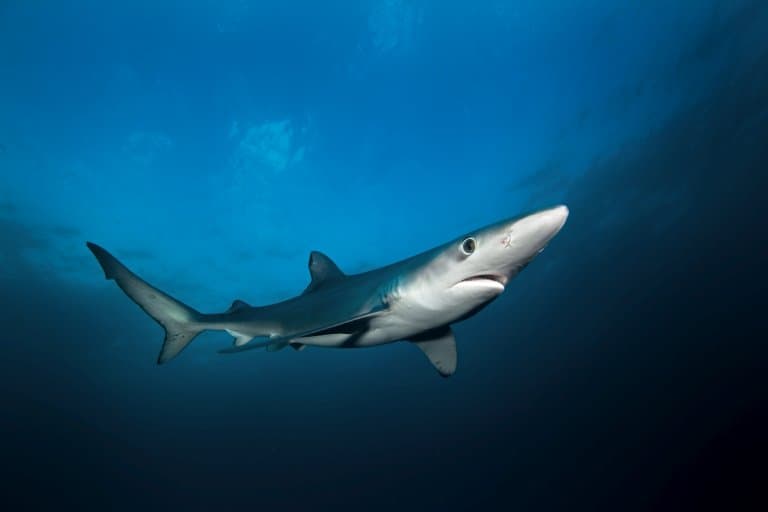
Sadly, this also results in the species being reduced to near threatened status by the IUCN.
Blue sharks are athletic and sleek, with the sort of vacant expression you’d expect from something so good-looking it’s never had to pay for its own meals.
These sharks mostly eat octopus and squid, as well as crustaceans, and being smaller than other toothy sharks, they’re also a food item themselves. They make up for this by being quite reproductive, and able to produce well over 100 pups in a single litter.
They commonly grow to over three meters, with the largest on the record being almost 4m long. 2
8. Tiger Shark (4.6 m / 15 ft)
These sharks have been found with almost everything you can imagine inside them including human remains, and have been called the trash can of the ocean.

They’re indiscriminate and frightening hunters, more aggressive than most sharks and one of the few that’s actually a common danger to swimmers in their habitat.
Shark attacks are still rare, but given the low bar for what tigers consider food, they may be the only shark that would deliberately hunt a person. Still, we kill a lot more of them than they do of us.
Between 1950 and 2008, 352 were killed in the nets in New South Wales alone. On their side, there are only 36 human fatalities attributed to tiger sharks. 3
7. Thresher Shark (4.6 m /15 ft)
We might be cheating somewhat here because Threshers represent a whole genus of sharks, but if we were to make this list at the species level, the next two entries would be other threshers, and since, as we’ll see, they’re cheating too, one entry for the genus seems fair.
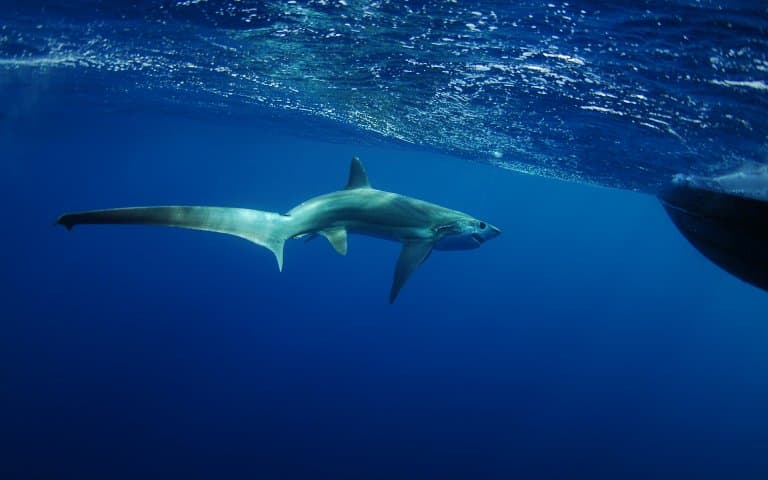
This is a shark that makes a joke of length measurements. Its face is stumpy and short, but it overcompensates with a disproportionate tail. This tail can be as long as the body of the shark and is used for both exceptional manoeuvrability and as a hunting weapon.
The largest of the three extant species, Alopias superciliosus, has been reported at up to 5.4m but this estimate is questionable and the most reliable is an impressive 460cm with a weight of 290kg. 4 5
6. Bluntnose Sixgill (5.5 m / 18 ft)
Another low-profile giant is again a globally-distributed biter of meat. Interestingly, this species has unconfirmed lengths that are lower than the maximum confirmed length.
The sixgill is a deep-water shark, using its oily liver as a buoyancy aid to maintain a depth of over 2,500 meters.

Part of this shark’s length is down to its particularly elongated tail fin, and its success is attributed to its diversity in feeding habits. Like its relative the Greenland shark, it’s capable of eating a variety of prey items using different hunting techniques.
It’s also thought to live a long time, and probably doesn’t stop growing, commonly reaching an average weight of 500kg, with the largest individuals perhaps reaching twice this.
Females may take 35 years to reach sexual maturity, which makes them vulnerable to population reductions as a result of human hunting and other interferences. As a result of these, the species is now listed as Near Threatened by the IUCN. 6
5. Greenland Shark (6.4 m / 21 ft)
This is considered the longest-living vertebrate and is likely so good at living due to its refrigerated habitat of deep, arctic seawater. They’ve been found as far down as 1,800 meters, and are thought to live upwards of 150 years.
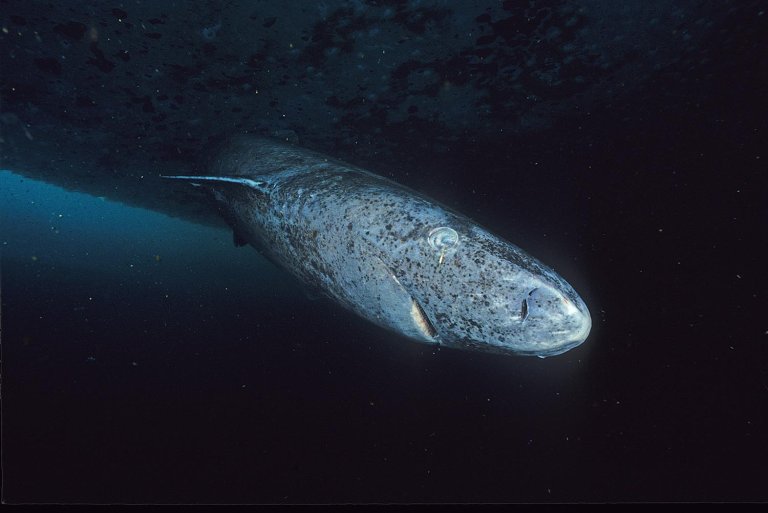
Greenland sharks move slowly, only really lunging into action when they come across a food item. Despite almost every individual being blinded by an eyeball parasite, they’re somehow able to catch and eat ringed seals on a regular basis.
They’re also one of the largest sharks. Averaging about 3 meters, they have been found over twice that size, and unlike most species, don’t appear to differ in size between the sexes.
Since nobody is afraid of Greenland sharks and they’re too ugly to draw in tourists, size estimates are more reliable than the more high-profile species. 7
4. Great White Shark (7 m / 23 ft)
This is certainly the largest shark in our imaginations and the biggest predatory shark of animals with bones and teeth and bank accounts.
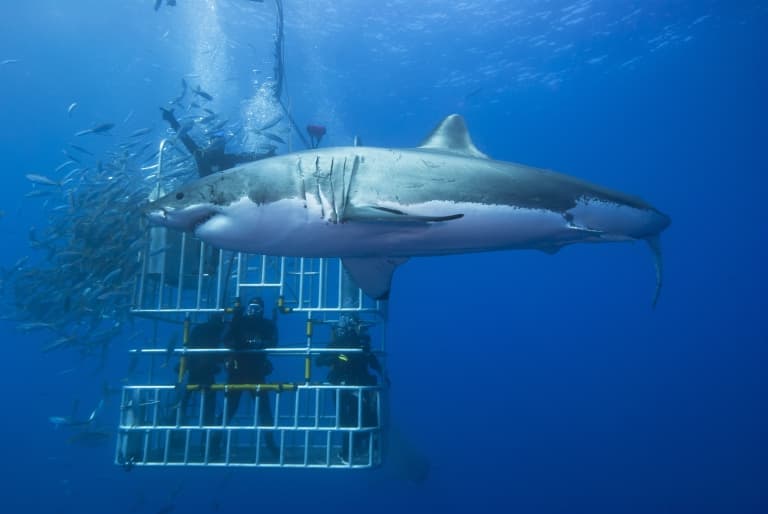
Actually, while these iconic sharks sometimes attack people, they do so very rarely, only in the ocean, and as far as we know, never on purpose.
Still, this anxiety around great whites leads to exaggerated claims of their size. As partially-thinking animals, we like to justify our irrational fears instead of overcoming them, and we do this by overblowing the threat in our minds to match our terror levels.
So, take most claims about great whites with a grain of salt, but from calculated estimates based on various other morphological measurements (e.g., one was the height of the pectoral fins) 7 meters have been validated by researchers.
A much more common average for white sharks is around four meters, though these are long-living and elusive animals, so it’s hardly surprising that they can grow much larger. 8
3. Megamouth Shark (7.1 m / 23 ft)
Megamouth sharks continue to surprise researchers. Until recently, this shark was once thought to be exceptionally rare, on account of nobody really seeing them. Only 50 specimens were known until 2010, after which new records emerged about its range, and with them, its maximum size.
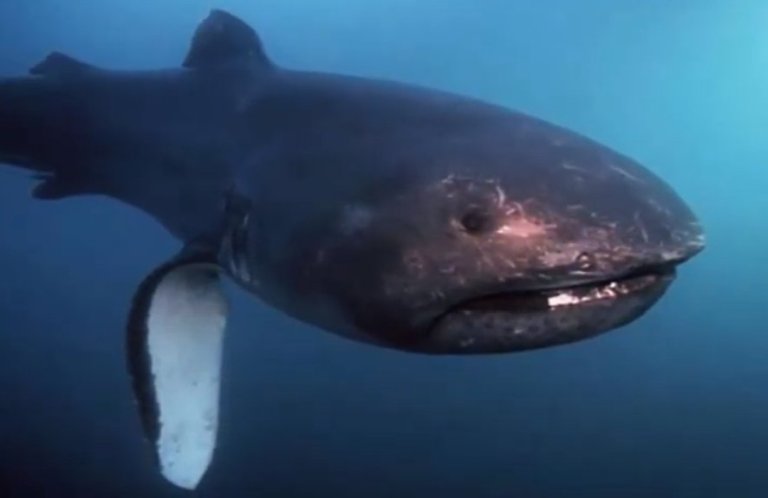
The maximum length of this shark was thought to be 4.5m, with a weight of around 750kg, which would have put it at number 7 on this list, but recently, the range and size of these sharks is becoming more evident.
Examples have now been recorded reaching past 7 meters in length, feeding at depths of up to a kilometre, and moving exceptionally slowly.
Like the other biggest sharks here, it’s a plankton feeder and achieves this with its comically large mouth.
There are unconfirmed claims of it reaching over 8 meters long, which would put it significantly ahead of the great white shark, though still a far cry from the basking shark.
Still, being such a recent discovery, there’s time for more exciting examples to be discovered. 9
2. Basking Shark (12.27 m / 40 ft)
These sharks are remarkably similar to whale sharks in several ways.
Aside from being much uglier, they occupy a similar niche, patrolling vast distances with their mouths open, gulping down plankton, and growing to gigantic proportions.
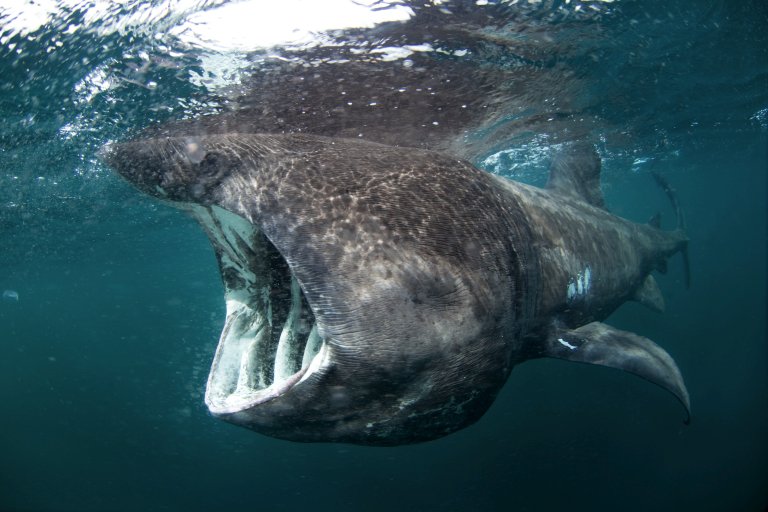
These are the second-largest fish, and again, they’re only a danger to you if you’re plankton or if you try to lift one on your back.
Basking sharks inhabit cooler waters than whale sharks and can migrate at depths of up to about a kilometre.
The largest of these ever reliably recorded was 12.27m, caught in a fishing net in the 1800s. Since they have to swim with their mouths open, scientists believe the increased drag involved put a limit on their size of around this amount, due to the relationship between the energy expenditure of feeding and the energy density of their food.
This is a very slow-moving animal, for obvious reasons, averaging less than 2mph while feeding. They’re mostly under 4 or 5 meters long but clearly can grow far bigger. 10
1. Whale Shark (18.8 m / 61.7 ft)
This one is unquestionable. The whale shark is a plankton-feeding colossus that occupies tropical waters all around the world. This is a spotted gentle giant and demonstrates a peaceful intelligence when interacting with divers.
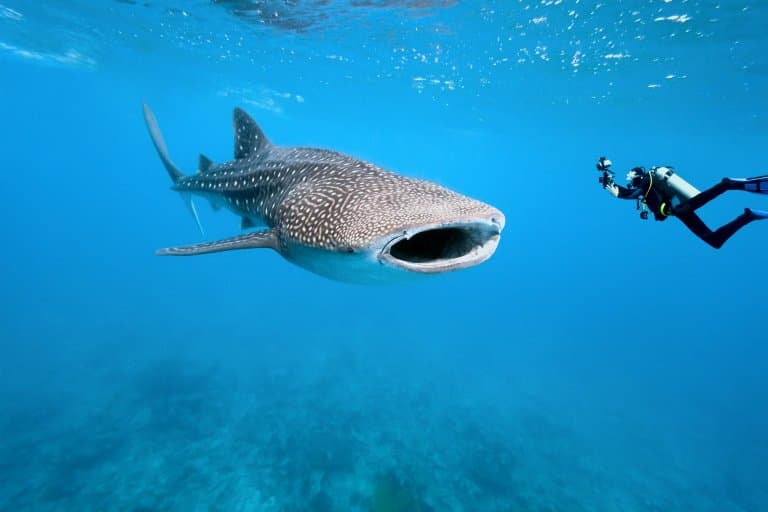
Sadly, they’re hunted for their livers, fins, and meat, and are often injured or killed by boats that they have come to associate with food. Whale sharks are now endangered and in desperate need of protection.
Despite wild claims of 20m and above, only 1 in 10 whale sharks ever reach sizes of above 4m; most of these are under 10m long. The longest sharks commonly reported are around 12m long.
There are, however, several reliable reports of ~18m whale sharks, and one dubious approximation of a 20-meter, 34-ton catch from Taiwan in the ‘90s.
Regardless, the whale shark is the largest shark, and one of the biggest creatures in the ocean! 11 12
Final Thoughts
This concludes our research on the biggest sharks in the world. But, does size matter?
For many people, the size of an animal is just about bragging rights, but for researchers, it’s an important trackable metric that has implications for the protection of the species and the environment in which it lives.
From size measurements, it’s possible to infer the physical, physiological and ecological properties of the animal, including how much it eats, how much energy it needs, and how much it recycles nutrients into the ecosystem.
All of this is critical for assessing the detailed significance of animals in their environment, and especially now, as the oceans approach depletion, we need these data to be as accurate as possible.
Fact Sources & References
- Michelle S. Passerotti, John K. Carlson, Andrew N. Piercy, Steven E. Campana (2021), “Age validation of great hammerhead shark (Sphyrna mokarran), determined by bomb radiocarbon analysis“, Southeast Fisheries Science Center.
- Rui Coelho et al. (2017), “Distribution patterns and population structure of the blue shark (Prionace glauca) in the Atlantic and Indian Oceans“, Fish & Fisheries.
- Carl G. Meyer et al. (2014), “Growth and Maximum Size of Tiger Sharks (Galeocerdo cuvier) in Hawaii“, PLOS One.
- Young, Chelsey N et al. (1966), “Status review report: common thresher (Alopias vulpinus) and bigeye thresher (Alopias superciliosus) sharks“, NMFS (National Marine Fisheries Service).
- Moreno, J; Moron, J (1992), “Reproductive biology of the Bigeye Thresher Shark“, Marine and Freshwater Research.
- Finucci, B., Barnett, A., Bineesh, K.K., Cheok, J., Cotton, C.F., Dharmadi, Graham, K.J., Kulka, D.W., Neat, F.C., Pacoureau, N., Rigby, C.L., Tanaka, S. & Walker, T.I (2020), “Hexanchus griseus“, The IUCN Red List of Threatened Species.
- Brendal Davis et al. (2013), “The Conservation of the Greenland Shark (Somniosus microcephalus): Setting Scientific, Law, and Policy Coordinates for Avoiding a Species at Risk“, Journal of International Wildlife Law & Policy.
- A. Peter Klimley, David G. Ainley (1996), “Great White Sharks: The Biology of Carcharodon Carcharias“, ScienceDirect.
- Yuuki Y. Watanabe, Yannis P. Papastamatiou (2019), “Distribution, body size and biology of the megamouth shark Megachasma pelagios“, Wiley.
- Mark Carwardine (2007), “Animal Records“, Natural History Museum.
- Dr. M (2013), “Whale Sharks and Giant Squids: Big or Bu!!$hit?“, Deep Sea News.
- Borrell, A., Aguilar, A., Gazo, M. et al. (2011), “Stable isotope profiles in whale shark (Rhincodon typus) suggest segregation and dissimilarities in the diet depending on sex and size“, SpringerLink.

